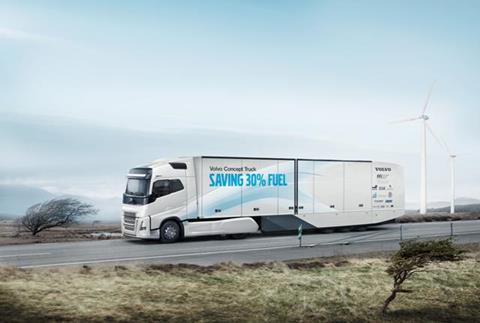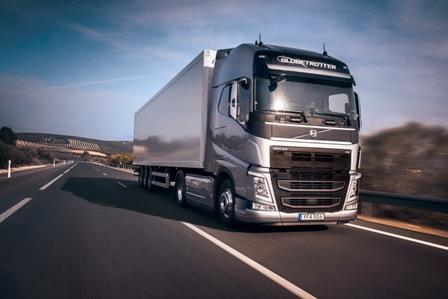
The EU has infuriated Europe’s major truck builders by setting highly challenging standards for cuts in CO2 emissions to be achieved in very short timescales.
Based on 2019/20 levels, heavy trucks must cut emissions 15% by 2025 and 30% by 2030 – without taking into account any adoption of low-carbon biofuels or how efficiently the operator uses the truck.
The truck makers’ association ACEA diplomatically called the regulations “highly ambitious” – code for almost impossible – and pointed out that any moves to increase use of low-carbon fuels such as natural gas and electricity are being held back by the lack of refuelling infrastructure, which is largely out of the truck makers’ hands.
We spoke to Lars Mårtensson, director of environment and innovations at Volvo Trucks, below, and received written responses from Daimler Trucks about the EU targets and how, after almost three decades of focusing on reducing local pollutants, NOx and particulates, the truck makers are going to find a way to make fast, deep cuts in CO2 emissions.

Initial target
The EU is initially targeting ‘large trucks’ over 16 tonnes GCW, which makes it even harder to achieve the reductions being called for, as low- and zero- emissions technologies are not yet suitable for larger goods vehicles.
“The two targets are based on the CO2 declarations that the manufacturers will have to make from this year for vehicles over 16 tonnes as a first step,” said Mårtensson. “There will be more steps coming for trucks below 16 tonnes.
“The first target of a 15% cut by 2025 will be the most difficult. This is a target where we are measured based on the average CO2 values for trucks that are registered by 2025. We will meet the target with existing technology and technology that is under development, as there is not enough time to start new development during this short time period.
“The 30% by 2030 is a higher number but it gives us more time.”
Daimler said: “We are continuously working on solutions to face these targets. Both of them are very ambitious and require the introduction of new technologies in an extremely short time, which poses a tremendous challenge to the entire commercial vehicles segment, since alternative technologies are still very costly and not yet economically feasible. At the same time, customers will only opt for alternatively powered vehicles if the necessary infrastructure required for charging and refuelling is set up swiftly in Europe.”
Potential routes
So what are the potential routes to achieving the 2025 target?
A number of OEMs including Volvo, Daimler, Scania and IVECO have developed natural gas trucks that are available at weights over 16 tonnes, including 44-tonne GCW tractor units, and although take-up has been limited so far in the UK, Mårtensson believes gas can play a role in achieving the targeted cuts.
“With gas trucks there is less carbon produced for each unit of energy even when using fossil-derived methane, so VECTO will show a 20% reduction in emissions for liquefied natural gas compared with diesel,” he explained. “For compressed natural gas it is a 14% reduction and there is growing interest in our LNG range. But all gas trucks make a significant contribution towards the 2025 target.”
Volvo and its sister company Renault Trucks are working closely to develop full battery electric trucks at weights up to 26 tonnes, but issues relating to cost, weight, range, battery life and recharging infrastructure need to be ironed out before wider adoption at the heavier end of the weight scale.
“Volvo handed over our first two full electric trucks to customers recently and they are the first steps on our journey towards electro-mobility,” said Mårtensson. “But there has to be a business case so customers see benefits from investing in this new, more expensive technology.
“Electric trucks will be a very important part of reaching the 2025 and 2030 targets.”
Many of the problems of electric trucks – except cost and lack of refuelling infrastructure – could be overcome by moving from batteries to hydrogen fuel cells, but this technology is even further away from volume production.
“We are looking at replacing the battery with a fuel cell, but the big problem today is the hydrogen,” said Mårtensson. “It is too expensive and 98% is produced from fossil fuels so it is not a competitive solution. But we are keeping the door open for its potential in future.”
Daimler too sees alternative fuels playing a part in achieving the targets. It said: “We offer our customers a wide range of products in the truck segment with both efficient and conventional diesel engines as well as alternative drivetrains, including natural gas (Actros NGT) and electric (eActros and eCanter) vehicles. We always consider and examine closely all technological options depending on economic feasibility, customer needs and sustainability.”
Efficiency improvements
But what is clear is that despite the emergence of alternative low-carbon fuels, the vast majority of trucks over 16 tonnes sold between 2020 and 2025 will be diesel-powered, and improvements in efficiency will be incremental rather than through any revolutionary new technology.
“One way is through the tyres to reduce rolling resistance, another is to improve aerodynamics and the third is to increase the efficiency of the driveline,” said Mårtensson.
“Volvo has, for example, just introduced I-Save, which includes several new technologies that can increase fuel economy by up to 7%.”

I-Save, available on the FH range, combines Volvo’s Euro-6 Step-D engine featuring turbo compounding and wave-shaped piston crowns with faster rear-axle ratios and an updated I-See predictive cruise control to maximise fuel efficiency on long-haul operations.
Mårtensson conceded that making similar gains in efficiency will be much harder for distribution trucks used on more stop-start operations.
The EU standards use a theoretical measure of CO2 emissions for each model of truck calculated using the VECTO software tool. These are based on tank-to-wheel emissions assuming fossil fuels are used, so no allowance will be made for vehicles that may be run on biofuels – gas or diesel – which can achieve cuts of up to 90% in well-to-wheel CO2 emissions.
“VECTO has been developed over the past 10 years within the EU and it is quite complex to simulate energy consumption in a heavy-duty vehicle,” said Mårtensson. “It would make life even more complicated to add biofuels to the picture. The EU has said it wants to look into biofuels but for now the measure is looking at the efficiency of trucks.”
While no-one can argue against the aims of cutting CO2 emissions from heavy vehicles, Europe’s truck makers have been made to focus on reducing NOx and particulate emissions since the late 1980s, and it is the speed rather than the scale of the cuts in CO2 that they object to.
“We now need to take huge steps in a very short time and this could have started earlier,” argued Mårtensson. “Talking to our customers, the desire to reduce their climate impact has been there for the past 10 or 15 years. But there has been a trade-off between air quality and CO2 and that will still be the case going forward.”













